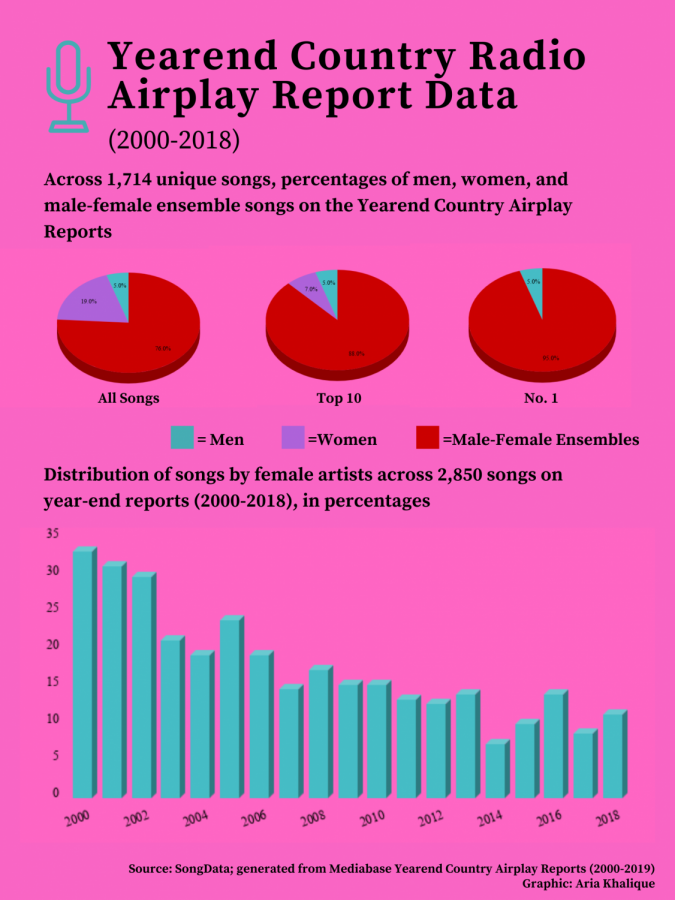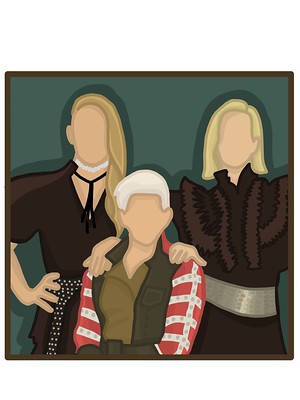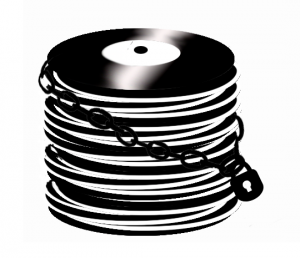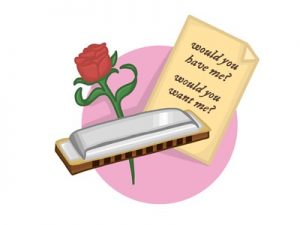- Arts & Entertainment
- Arts and Entertainment: Best of 2020-21
- Best of SNO
- Issue 3: Arts and Entertainment 2020-21
- SUMMER OVERHAUL 2020-21
- Ω Issue 3: 2020-21
The bro-country subgenre silences female voices, preventing country music from progressing forward
The declining value of female voices in the country music industry can be easily seen through radio airplay statistics.
December 2, 2020
“Slide your sugar-shaker over here… shake it for me girl… let me see you do it in the bed of my truck.” Those are just some of the offensive, sexist and poorly written lyrics consistently heard on country radio as part of the bro-country era. And as the subgenre has developed, not only are these songs more abundant than ever, they devalue female country artists and disincentivize them from making music today.
For those who don’t know or couldn’t guess, bro-country is the most popular subgenre of country music currently. It’s characterized by strong guitar and computerized drums bordering on pop but having just enough elements to pass as country. Vulture journalist Jody Rosen defined it best as “music by and of the tatted, gym-toned, party-hearty young American white dude.”
Now, country music has always had elements of this before. There have always been songs about trucks and drinking but never so many consecutively using the same tropes and same sounds until now.
The official bro-country movement one could say started around 2010 with prominent artists like Luke Bryan, Blake Shelton and Florida Georgia Line releasing music all talking about jeans so tight they were painted on, parties and drinking. It took off after that.
Once these songs began to gain momentum, the formula for a successful country song was found. Hundreds of other men began to throw together the same stories of driving in Chevys and tanned legs. Besides glamorizing drinking and recycling the same beats and words in every song, the worst part of this movement is how men began speaking for women, portraying them as objects only good for making men happy. Suddenly women were stripped of their own voice, and as bro-country became the frontrunning sound in the industry, women lost the means of making themselves heard.
The values of misogyny promoted by these songs have seeped into the country music industry as a whole and made it so female voices are less valuable and female artists are just not as important. The biggest example of this is country radio.
Country charts and awards thrive heavily on radio play to this day. And if you aren’t played on the radio, you’re most likely not going to get recognized. With radio executives capitalizing on the bro-country crowd and tailoring plays towards them, female artists are a rarity to hear.
Jada Robinson, a musicologist at NBC News explains that there is a “significant disparity” in plays between women and men and cites that the gap has increased from a 2 to 1 ratio in the year 2000 to 9.7 to 1 in 2018.
The devaluing lyrics of most bro-country songs definitely plays a role in radio executives’ decision to not play female artists. Because not only do listeners absorb the values of sexism, they also grow comfortable to a certain style of music and lyricism.
“Audiences respond more favorably to what they hear and know, and audiences know songs by men. By limiting airplay for songs by women to less than 10 percent of the daytime spins, radio is not offering women the same platform for development and exposure as male artists, making their voices and stories unfamiliar to audiences,” Robinson says.
Radio listeners’ and executives’ decision to not branch out from their limited comfort levels creates larger issues as well.
Robinson explains that “Airplay and chart activity is crucial exposure for artists — especially new artists, as it is linked to other opportunities, including label and publishing deals, touring and festival opportunities, award nominations, fan clubs, merchandising and more. Naturally, the declining presence of women on radio evolves into a sustained, industry-wide deficit.”
Fast-forward to the 2020 CMA (Country Music Association) awards where the “industry-wide deficit” is furthered with Morgan Wallen winning New Artist of the Year over Ingrid Andress. How did the man who disgraced the name of country music after being uninvited to perform on Saturday Night Live due to his lack of social distancing win over the woman whose single was certified Platinum this year? Gabby Barret and Carly Pearce were also nominated alongside Wallen, clearly illustrating that even high-up executives aren’t comfortable hearing a woman’s perspective.
Worse than not being played on radio, female voices aren’t even receiving recognition from award shows, delivering a message that new ideas just don’t have value in the industry. Senior vice-president of music and talent at CMT (Country Music Television) Leslie Fram said it best: “We’re training people not to hear female voices.”
The equation is simple. Not awarding plus not playing plus continuously objectifying female voices song after song equals lack of respect for women and their work. And this lack of respect translates into declining success for all artists, ultimately making it extremely discouraging to be a woman in country music right now.
Full Frontal with Samantha Bee dedicates a segment to investigating sexism in country music with Bee commenting that “it’s harder to be a woman country artist in 2020 than it was two decades ago.”
While shedding a light on the current state of country music, Bee also offers an important contrast between today and the 1990s. Contrary to the present, the 1990s were dominated by female country artists. Women like Shania Twain, Martina McBride, Trisha Yearwood and The Chicks (former Dixie Chicks) were hugely successful throughout the decade.
Collectively, these women received eight Grammy awards and 14 CMA awards between 1990-1999. The reason for their success? Being allowed to use their voices to tell stories that matter.
Country singer Carly Pearce told Billboard, “Every time you turned on the radio, these women owned. They were so different, yet represented women who embraced and wrote about what they were going through … fans saw women dreaming up their own narratives and directing the conversation themselves.”
This value of embracing the female perspective made way for incredibly nuanced music. The industry was home to different ideas and women of all types could see themselves reflected in songs like Shania Twain’s empowering single “Man! I Feel Like A Woman”. The Chicks’ spiteful “Goodbye Earl” talks of a woman taking control after she leaves an abusive marriage, McBride’s “A Broken Wing” highlights emotional manipulation in a relationship and Yearwoods “XXX’s and OOO’s (An American Girl)” tells a story of a girl who looks up to her mother.
In addition to awarding female songs, in the year 2000 women made up one third of all radio plays (NBC News). Granted, this statistic isn’t ideal as well, but in the year 2020 shouldn’t we be moving forward instead of decreasing this number by two-thirds to 11.3 percent?
In the ‘90s, women were given value and their opinions were important and that made for a diverse industry where individuals outside the genre didn’t stereotype it as solely about trucks, girls and beer.
Bro-country has taken over the country music industry and not only does this make more bland music, it portrays country music in a negative light to people unfamiliar with the genre.
In a survey, 6 out of 10 Dougherty Valley students responded “guitar” and “trucks” as the first things they think of when they think of country music.
This is simply due to the lack of nuanced and diverse opinions in the industry. Sexist songs about partying are all people know and because of that, bro-country has turned the genre into a caricature where outside viewers laugh at it’s redundancy. This is not just damaging to the industry, it does a disservice to longtime fans of country music who no longer see themselves represented.
“Anyone that loves country music despite where you fall on the political spectrum, no matter who it is that you are, ask yourself this question: whether you want your daughter to know about herself and if you can’t get that from country music and you can’t get that from country radio then theres a problem,” Brandi Carlile, one of the only openly gay artists in the industry, explained to Bee.
The solution to the longtime problem Carlile talks about is not simple. Bro-country has made an everlasting imprint on a generation of country listeners and the values it has advocated will take time to unlearn.
What can be done now is to give female artists their voices back. Decrease the disparity in radio plays and recognize hard work by awarding women. However, until radio executives and award committees understand the destruction they have caused to their own industry, country fans and non-fans alike can increase their own exposure to female voices. Through music streaming platforms it is easier than ever to discover new music. And by increasing the popularity of up-and-coming artists such as Pearce, Andress, Margo Price, Maddie & Tae, Runaway June and Tenille Townes as well as women of color such as Yola, Mickey Guyton, Brittney Spencer and Rhiannon Giddens, maybe the leaders of country music will finally figure out they have robbed an entire generation of hearing complex female perspectives.
Perhaps then they will feel compelled to acknowledge and embrace these voices, ensuring that the industry can go beyond breaking the stereotype of bro-country and transition into being a nuanced genre abundant with diverse perspectives.







Maya Krishnan • Dec 8, 2020 at 7:19 pm
Great article! As a country lover I have unfortunately learned that country radio is not where any of the good country music is found. Often I have to do a lot of digging into the depths of Spotify to find the good music I love! Which is often by female artists 😉 Thank you for bringing awareness to this topic!